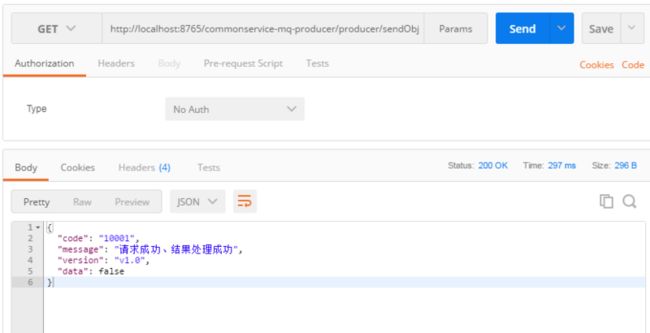在使用spring cloud云架构的时候,我们不得不使用Spring cloud Stream,因为消息中间件的使用在项目中无处不在,我们公司后面做了娱乐方面的APP,在使用spring cloud做架构的时候,其中消息的异步通知,业务的异步处理都需要使用消息中间件机制。spring cloud的官方给出的集成建议(使用rabbit mq和kafka),我看了一下源码和配置,只要把rabbit mq集成,kafka只是换了一个pom配置jar包而已,闲话少说,我们就直接进入配置实施:
- 简介:
Spring cloud Stream 数据流操作开发包,封装了与Redis,Rabbit、Kafka等发送接收消息。
- 使用工具:
rabbit,具体的下载和安装细节我这里不做太多讲解,网上的实例太多了
- 创建commonservice-mq-producer消息的发送者项目,在pom里面配置stream-rabbit的依赖
1.
2.
3. org.springframework.cloud
4. spring-cloud-starter-stream-rabbit
5. - 在yml文件里面配置rabbit mq
1. server:
2. port: 5666
3. spring:
4. application:
5. name: commonservice-mq-producer
6. profiles:
7. active: dev
8. cloud:
9. config:
10. discovery:
11. enabled: true
12. service-id: commonservice-config-server
13. # rabbitmq和kafka都有相关配置的默认值,如果修改,可以再次进行配置
14. stream:
15. bindings:
16. mqScoreOutput:
17. destination: honghu_exchange
18. contentType: application/json
20. rabbitmq:
21. host: localhost
22. port: 5672
23. username: honghu
24. password: honghu
25. eureka:
26. client:
27. service-url:
28. defaultZone: http://honghu:123456@localhost:8761/eureka
29. instance:
30. prefer-ip-address: true - 定义接口ProducerService
1. package com.honghu.cloud.producer;
3. import org.springframework.cloud.stream.annotation.Output;
4. import org.springframework.messaging.SubscribableChannel;
6. public interface ProducerService {
8. String SCORE_OUPUT = "mqScoreOutput";
10. @Output(ProducerService.SCORE_OUPUT)
11. SubscribableChannel sendMessage();
12. } - 定义绑定
1. package com.honghu.cloud.producer;
3. import org.springframework.cloud.stream.annotation.EnableBinding;
5. @EnableBinding(ProducerService.class)
6. public class SendServerConfig {
8. } - 定义发送消息业务ProducerController
1. package com.honghu.cloud.controller;
4. import org.springframework.beans.factory.annotation.Autowired;
5. import org.springframework.integration.support.MessageBuilder;
6. import org.springframework.messaging.Message;
7. import org.springframework.web.bind.annotation.PathVariable;
8. import org.springframework.web.bind.annotation.RequestBody;
9. import org.springframework.web.bind.annotation.RequestMapping;
10. import org.springframework.web.bind.annotation.RequestMethod;
11. import org.springframework.web.bind.annotation.RestController;
13. import com.honghu.cloud.common.code.ResponseCode;
14. import com.honghu.cloud.common.code.ResponseVO;
15. import com.honghu.cloud.entity.User;
16. import com.honghu.cloud.producer.ProducerService;
18. import net.sf.json.JSONObject;
20. @RestController
21. @RequestMapping(value = "producer")
22. public class ProducerController {
24. @Autowired
25. private ProducerService producerService;
28. /**
29. * 通过get方式发送对象
30. * @param name 路径参数
31. * @return 成功|失败
32. */
33. @RequestMapping(value = "/sendObj", method = RequestMethod.GET)
34. public ResponseVO sendObj() {
35. User user = new User(1, "hello User");
36. Message msg = MessageBuilder.withPayload(user).build();
37. boolean result = producerService.sendMessage().send(msg);
38. if(result){
39. return ResponseCode.buildEnumResponseVO(ResponseCode.RESPONSE_CODE_SUCCESS, false);
40. }
41. return ResponseCode.buildEnumResponseVO(ResponseCode.RESPONSE_CODE_FAILURE, false);
42. }
45. /**
46. * 通过get方式发送字符串消息
47. * @param name 路径参数
48. * @return 成功|失败
49. */
50. @RequestMapping(value = "/send/{name}", method = RequestMethod.GET)
51. public ResponseVO send(@PathVariable(value = "name", required = true) String name) {
52. Message msg = MessageBuilder.withPayload(name.getBytes()).build();
53. boolean result = producerService.sendMessage().send(msg);
54. if(result){
55. return ResponseCode.buildEnumResponseVO(ResponseCode.RESPONSE_CODE_SUCCESS, false);
56. }
57. return ResponseCode.buildEnumResponseVO(ResponseCode.RESPONSE_CODE_FAILURE, false);
58. }
60. /**
61. * 通过post方式发送json对象
62. * @param name 路径参数
63. * @return 成功|失败
64. */
65. @RequestMapping(value = "/sendJsonObj", method = RequestMethod.POST)
66. public ResponseVO sendJsonObj(@RequestBody JSONObject jsonObj) {
67. Message msg = MessageBuilder.withPayload(jsonObj).build();
68. boolean result = producerService.sendMessage().send(msg);
69. if(result){
70. return ResponseCode.buildEnumResponseVO(ResponseCode.RESPONSE_CODE_SUCCESS, false);
71. }
72. return ResponseCode.buildEnumResponseVO(ResponseCode.RESPONSE_CODE_FAILURE, false);
73. }
74. }
75. - 创建commonservice-mq-consumer1消息的消费者项目,在pom里面配置stream-rabbit的依赖
1.
2.
3. org.springframework.cloud
4. spring-cloud-starter-stream-rabbit
5. - 在yml文件中配置:
1. server:
2. port: 5111
3. spring:
4. application:
5. name: commonservice-mq-consumer1
6. profiles:
7. active: dev
8. cloud:
9. config:
10. discovery:
11. enabled: true
12. service-id: commonservice-config-server
14. stream:
15. bindings:
16. mqScoreInput:
17. group: honghu_queue
18. destination: honghu_exchange
19. contentType: application/json
21. rabbitmq:
22. host: localhost
23. port: 5672
24. username: honghu
25. password: honghu
26. eureka:
27. client:
28. service-url:
29. defaultZone: http://honghu:123456@localhost:8761/eureka
30. instance:
31. prefer-ip-address: true - 定义接口ConsumerService
1. package com.honghu.cloud.consumer;
3. import org.springframework.cloud.stream.annotation.Input;
4. import org.springframework.messaging.SubscribableChannel;
6. public interface ConsumerService {
8. String SCORE_INPUT = "mqScoreInput";
10. @Input(ConsumerService.SCORE_INPUT)
11. SubscribableChannel sendMessage();
13. } - 定义启动类和消息消费
1. package com.honghu.cloud;
3. import org.springframework.boot.SpringApplication;
4. import org.springframework.boot.autoconfigure.SpringBootApplication;
5. import org.springframework.cloud.netflix.eureka.EnableEurekaClient;
6. import org.springframework.cloud.stream.annotation.EnableBinding;
7. import org.springframework.cloud.stream.annotation.StreamListener;
9. import com.honghu.cloud.consumer.ConsumerService;
10. import com.honghu.cloud.entity.User;
12. @EnableEurekaClient
13. @SpringBootApplication
14. @EnableBinding(ConsumerService.class) //可以绑定多个接口
15. public class ConsumerApplication {
17. public static void main(String[] args) {
18. SpringApplication.run(ConsumerApplication.class, args);
19. }
21. @StreamListener(ConsumerService.SCORE_INPUT)
22. public void onMessage(Object obj) {
23. System.out.println("消费者1,接收到的消息:" + obj);
24. }
26. } 可以看到接收到了消息,下一章我们介绍mq的集群方案。
到此,整个消息中心方案集成完毕(企业架构源码可以加求球:叁五三陆二肆柒二伍玖)
欢迎大家和我一起学习spring cloud构建微服务云架构,我这边会将近期研发的spring cloud微服务云架构的搭建过程和精髓记录下来,帮助更多有兴趣研发spring cloud框架的朋友,大家来一起探讨spring cloud架构的搭建过程及如何运用于企业项目。

